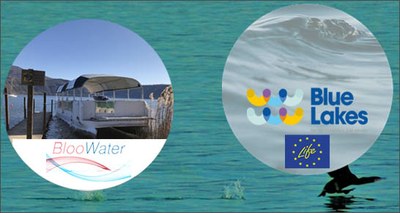Environment: Lakes, ENEA takes action against cyanobacteria and microplastics
16/7/2020
 ENEA takes action against cyanobacteria, the so-called green-blue algae, and microplastics, the two emergencies which affect lakes in Italy and throughout the world, with effects on human health, ecosystems, quality of drinking water and economic activities. The activities are part of the projects BlooWater and Blue Lakes, coordinated respectively by ENEA and Legambiente.
ENEA takes action against cyanobacteria, the so-called green-blue algae, and microplastics, the two emergencies which affect lakes in Italy and throughout the world, with effects on human health, ecosystems, quality of drinking water and economic activities. The activities are part of the projects BlooWater and Blue Lakes, coordinated respectively by ENEA and Legambiente.
The project BlooWater against cynobacteria has the objective of developing innovative technological solutions and new methodologies to monitor and treat the lakes of Albano (Rome) and Castreccioni (Macerata) in Italy and Erken (north of Stockholm) and Mälaren in Sweden.
In addition to ENEA, Polytechnic University of the Marches, Uppsala University (Sweden) and Norwegian Institute for Water Research (NIVA) take part in the project.
As part of the project and by 2022, the researchers at the ENEA Biodiversity and Ecosystem Services Laboratory, jointly with the other partners, have the task of developing monitoring systems for algal blooms through the integration of satellite and drone images, with analysis of water samples, forecasting models and early warning and decision support systems and innovative methods for the treatment of fresh water for drinking use.
Fighting cyanobacteria is crucial, as they are responsible for algal blooms that can release toxic substances –cyanotoxins- contaminating drinking water.
In 2014, for instance, the inhabitants of Toledo, Ohio, remained without water for three days due to an exceptional algal bloom of cyanobacteria and in Italy 12 regions out of 20 are hit by this phenomenon. Periodic blooms of the cyanobacterium also occurred in the Lazio lakes of Vico, Albano e Nemi .
Toxic algal blooms from cyanobacteria have been reported for decades all over the world, but in recent years they seem to have increased in several environments at all latitudes. Some authors explicitly link the increase in cyanobacteria to global warming, which could act as a catalyst.
"Climate change and pollution are among the main causes of toxic algal blooms that cyclically occur in lakes and seas of industrialized and developing countries and, more generally, in densely populated areas where the effects of anthropic activities are greatest", Maria Sighicelli, at the ENEA Sustainability of Production and Territorial Systems Department, pointed out.
"Potential risks to public health derive from the use of drinking water and fish products from contaminated lakes, the use of water for hygiene and health and recreational purposes," he said.
Fight against microplastics – project Blue Lakes
The LIFE Blue Lakes project aims at reducing and preventing microplastics waste in Italian and German lakes, developing shared protocols of sampling and analysis methods and promoting diffusion of good practices to be extended to institutions, bodies and local authorities, companies and citizens. The project, which is coordinated by Legambiente and co-funded by PlasticsEurope, includes ENEA, Arpa Umbria, Central Italy Basin Authority, Global Nature Fund, Lake Constance Foundation and Polytechnic University of Marche.
In particular, technical protocols and a series of ad hoc actions will be developed including: a Lake Charter, containing indications for reducing the environmental impact, awareness raising activities, advocacy campaigns for companies and institutional tables.
According to data by ENEA and Goletta dei Laghi, microplastics, i.e. plastic particles of less than 5 millimeters, are increasingly endangering Italian lakes, with a growing trend in the three-year period 2017-2019: in Lake Garda the average concentration of plastic microparticles per km2 went from approximately 10 thousand in 2017 to over 130 thousand in 2019; in Lake Trasimeno from 8 thousand to 25 thousand, while in Lake Bracciano from 117 thousand to over 390 thousand.
In all lakes the debris predominantly found over the three-year span were fragments deriving from the disaggregation of leftover plastic waste, followed by films (usually from packaging) in central Italy lakes, and filaments (from clothes-washing) and polystyrene balls (often from crates and packaging) in Lake Garda. The most frequent type of polymer is polyethylene, one of the most common synthetic polymers.
"The analysis of data and sampling methods shows the need to increase and improve the protocols developed so far to make them suitable to the morphological characteristics of each lake and the size of the water body for greater spatial coverage, according to terrestrial inputs and seasonal winds but more generally to a standard to be submitted to the institutions in charge of environmental protection, and the project is an opportunity to test the protocols ENEA has developed over the years ", Sighicelli concluded.
